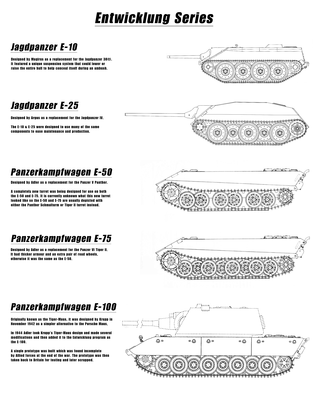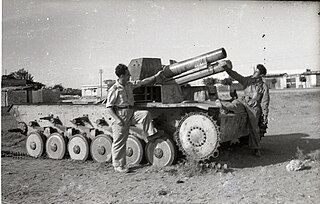
The Panzer I was a light tank produced by Nazi Germany in the 1930s. Its name is short for Panzerkampfwagen I, abbreviated as PzKpfw I. The tank's official German ordnance inventory designation was Sd.Kfz. 101.

The Panzer II is the common name used for a family of German tanks used in World War II. The official German designation was Panzerkampfwagen II.

Panzerkampfwagen VIII Maus was a German World War II super-heavy tank completed in late 1944. It is the heaviest fully enclosed armored fighting vehicle ever built. Five were ordered, but only two hulls and one turret were completed, the turret being attached before the testing grounds were captured by advancing Soviet military forces.

The 3.7 cm Flak auf Fahrgestell Panzerkampfwagen IV (sf), nicknamed Möbelwagen because of its boxy shape, was a self-propelled anti-aircraft gun built from the chassis of the Panzer IV tank. It was used by the Wehrmacht in the European Theatre of World War II.

The 15 cm sIG 33 (Sf) auf Panzerkampfwagen 38(t), also known as Grille was a series of self-propelled artillery vehicles used by Nazi Germany during World War II. The Grille series was based on the Czech Panzer 38(t) tank chassis and used a 15 cm sIG 33 infantry gun.

The Entwicklung series, more commonly known as the E-Series, was a late-World War II attempt by Nazi Germany to produce a standardised series of tank designs. There were to be standard designs in five different weight classes from which several specialised variants were to be developed. This intended to reverse the favor of extremely complex tank designs that had resulted in poor production rates and mechanical unreliability.

The German Panzerkampfwagen Neubaufahrzeug, abbreviated as PzKpfw Nb.Fz, series of tank prototypes were a first attempt to create a medium tank for the Wehrmacht after Adolf Hitler had come to power. Multi-turreted, heavy and slow, they were not considered successful, which led to only five being produced. These were primarily used for propaganda purposes and training, though three took part in the Battle of Norway in 1940. Pictures of the Neubaufahrzeuge were displayed with different turret models and orientations to fool allied spies; American and Soviet agents independently reported that the Germans had two new heavy tanks, the Panzer V and VI. In reality, these tanks were far from the Panzer V Panther and the Panzer VI Tiger.

The Panzerkampfwagen VII Löwe (Lion) was a design for a super-heavy tank created by Krupp for the German government during World War II. The project, initially code-named VK 70.01 (K), never left the drawing board, and was dropped on 5–6 March 1942, in favor of Porsche's heavier Panzer VIII Maus.
The Panzerkampfwagen I was a light tank produced in Germany in the 1930s. The Panzer I was built in several variants and was the basis for a number of variants listed below.

The Panzerkampfwagen E-100 (TG-01) was a German super-heavy tank design developed towards the end of World War II. It was the largest of the Entwicklung series of tank designs which was intended to improve German armored vehicle production through standardization on cheaper, simpler to build vehicles. By the end of the war, the chassis of the prototype E-100 had been partially completed; it was shipped to the United Kingdom for trials, but was later scrapped.

The 4.7 cm KPÚV vz. 38 (Czech: kanón proti útočné vozbě vzor 38) is an anti-tank gun produced by the Škoda Works that saw service in World War II. Originally designed for the Czechoslovak Army, some were also sold to Yugoslavia. A number were appropriated by the Germans after the German occupation of Czechoslovakia in 1939 and used under the names 4.7 cm PaK (t) or PaK 38(t). The Germans continued production and mounted the PaK 38(t) on the Panzerkampfwagen I chassis as the Panzerjäger I tank destroyer. A similar attempt to mount it on the chassis of captured Renault R-35 tanks was less successful.

The 15 cm sIG 33 auf Fahrgestell Panzerkampfwagen II (Sf), sometimes referred to as the Sturmpanzer II Bison, was a German assault gun used during World War II. The dozen vehicles produced were assigned to the 90th Light Infantry Division in North Africa during the war.

The 10.5 cm K gepanzerte Selbstfahrlafette, also known as the Panzer Selbstfahrlafette IV Ausf. A was a prototype self-propelled gun used by Nazi Germany during World War II. Although it was originally designed as a Schartenbrecher for use against the French Maginot Line defences, following the defeat of France in 1940, it was evaluated for use as a tank destroyer on the Eastern Front.
The Panzerkampfwagen III/IV was an experimental medium tank project undertaken by Germany during World War II. The tank was designed to use components of both the Panzer III and Panzer IV, in an attempt to integrate the two projects. The project was cancelled with only the blueprints developed, and no units were ever built.

The Schmalturm was a tank turret designed for use on the Panther Ausf. F medium tank. There was a Krupp proposal to fit it onto the Panzer IV medium tank as well. It featured a narrow front to maximize protection while minimizing weight. It was both lighter and easier to manufacture than the standard Panther turret. The turret had a stereoscopic rangefinder with lenses on either side of the turret, located in spherical bulges. No Schmalturms entered series production.

The Nebelkerzenabwurfvorrichtung was a rear mounted grenade dispenser used to disperse the Schnellnebelkerze 39 smoke grenade. It was typically found on German tanks from 1939 through 1942.

The Nebelwurfgerät was a turret mounted launcher used to disperse the Schnellnebelkerze 39 smoke grenade. It was typically found on German tanks from 1942 through 1943.

The Panzerkampfwagen I Ausf. F, also known as VK 18.01, was a German light tank from World War II. Despite the fact that it was designated as a modification of the light tank Panzer I, the VK.18.01 was a completely new vehicle, had almost nothing to do with it. The Pz.Kpfw.I Ausf.F was created in 1942 as a light tank designed to storm fortified lines. In that same year, 30 units were produced. From 1943 it was used for anti-guerrilla operations on the Eastern Front and in Yugoslavia. Thirty Ausf F tanks were built between April and December 1942, eight of which were sent to the Eastern Front for evaluation.

The Panzerkampfwagen I Ausf. C, also known by its prototype name VK 6.01, was a German light tank from the Second World War. Although the Panzer I Ausf. C was formally designated as a modification of the Panzer I, it was actually a completely new vehicle. This variant has little similarity with earlier Ausf. A and B variants - one of the main distinctions being the use of the Schachtellaufwerk inter-leaved track wheels which was used in many later German tanks during the war.


















